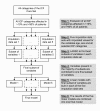Patients' functioning as predictor of nursing workload in acute hospital units providing rehabilitation care: a multi-centre cohort study
- PMID: 21034438
- PMCID: PMC2988780
- DOI: 10.1186/1472-6963-10-295
Patients' functioning as predictor of nursing workload in acute hospital units providing rehabilitation care: a multi-centre cohort study
Abstract
Background: Management decisions regarding quality and quantity of nurse staffing have important consequences for hospital budgets. Furthermore, these management decisions must address the nursing care requirements of the particular patients within an organizational unit. In order to determine optimal nurse staffing needs, the extent of nursing workload must first be known. Nursing workload is largely a function of the composite of the patients' individual health status, particularly with respect to functioning status, individual need for nursing care, and severity of symptoms. The International Classification of Functioning, Disability and Health (ICF) and the derived subsets, the so-called ICF Core Sets, are a standardized approach to describe patients' functioning status. The objectives of this study were to (1) examine the association between patients' functioning, as encoded by categories of the Acute ICF Core Sets, and nursing workload in patients in the acute care situation, (2) compare the variance in nursing workload explained by the ICF Core Set categories and with the Barthel Index, and (3) validate the Acute ICF Core Sets by their ability to predict nursing workload.
Methods: Patients' functioning at admission was assessed using the respective Acute ICF Core Set and the Barthel Index, whereas nursing workload data was collected using an established instrument. Associations between dependent and independent variables were modelled using linear regression. Variable selection was carried out using penalized regression.
Results: In patients with neurological and cardiopulmonary conditions, selected ICF categories and the Barthel Index Score explained the same variance in nursing workload (44% in neurological conditions, 35% in cardiopulmonary conditions), whereas ICF was slightly superior to Barthel Index Score for musculoskeletal conditions (20% versus 16%).
Conclusions: A substantial fraction of the variance in nursing workload in patients with rehabilitation needs in the acute hospital could be predicted by selected categories of the Acute ICF Core Sets, or by the Barthel Index score. Incorporating ICF Core Set-based data in nursing management decisions, particularly staffing decisions, may be beneficial.
Figures




References
-
- Royal College of Nursing (RCN) Defining nursing. http://www.rcn.org.uk/__data/assets/pdf_file/0008/78569/001998.pdf accessed at 07.05.2010. - PubMed
-
- Bridel JE. Why measure workload? Prof Nurse. 1993;8:362–365. - PubMed
Publication types
MeSH terms
LinkOut - more resources
Full Text Sources
Medical

